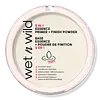What's inside
What's inside
 Key Ingredients
Key Ingredients

 Benefits
Benefits

 Concerns
Concerns

 Ingredients Side-by-side
Ingredients Side-by-side

Talc
AbrasiveMica
Cosmetic ColorantMethyl Methacrylate Crosspolymer
Zea Mays Starch
AbsorbentDimethicone
EmollientSilica
AbrasiveNylon-12
Ethylhexyl Palmitate
EmollientTriethoxycaprylylsilane
Magnesium Stearate
Cosmetic ColorantLauroyl Lysine
Skin ConditioningPrunus Amygdalus Dulcis Oil
Skin ConditioningPhenoxyethanol
PreservativeCI 77492
Cosmetic ColorantWater
Skin ConditioningTocopheryl Acetate
AntioxidantEthylhexylglycerin
Skin ConditioningRosa Rugosa Flower Extract
Skin ConditioningPropylene Glycol
HumectantCI 77891
Cosmetic ColorantCI 77491
Cosmetic ColorantCI 77499
Cosmetic ColorantTalc, Mica, Methyl Methacrylate Crosspolymer, Zea Mays Starch, Dimethicone, Silica, Nylon-12, Ethylhexyl Palmitate, Triethoxycaprylylsilane, Magnesium Stearate, Lauroyl Lysine, Prunus Amygdalus Dulcis Oil, Phenoxyethanol, CI 77492, Water, Tocopheryl Acetate, Ethylhexylglycerin, Rosa Rugosa Flower Extract, Propylene Glycol, CI 77891, CI 77491, CI 77499
Mica
Cosmetic ColorantSilica
AbrasiveZinc Stearate
Cosmetic ColorantDimethicone
EmollientTrimethylsiloxysilicate
EmollientCaprylic/Capric Triglyceride
MaskingPhenoxyethanol
PreservativeCaprylyl Glycol
EmollientEthylhexylglycerin
Skin ConditioningHexylene Glycol
EmulsifyingSodium Dehydroacetate
PreservativeEthylhexyl Methoxycinnamate
UV AbsorberWater
Skin ConditioningBisabolol
MaskingPentaerythrityl Tetra-Di-T-Butyl Hydroxyhydrocinnamate
AntioxidantMalachite Extract
AntioxidantZingiber Officinale Root Extract
MaskingBHT
AntioxidantCI 77492
Cosmetic ColorantMica, Silica, Zinc Stearate, Dimethicone, Trimethylsiloxysilicate, Caprylic/Capric Triglyceride, Phenoxyethanol, Caprylyl Glycol, Ethylhexylglycerin, Hexylene Glycol, Sodium Dehydroacetate, Ethylhexyl Methoxycinnamate, Water, Bisabolol, Pentaerythrityl Tetra-Di-T-Butyl Hydroxyhydrocinnamate, Malachite Extract, Zingiber Officinale Root Extract, BHT, CI 77492
Ingredients Explained
These ingredients are found in both products.
Ingredients higher up in an ingredient list are typically present in a larger amount.
Ci 77492 is also hydrated iron III oxide. It's sole purpose is to give a yellow hue to products.
Iron III oxides are classified as inorganic chemicals for coloring.
Synthetically created Ci 77492 is considered safer than those naturally found. This is because the synthetically created version may contain less impurities. Iron oxides are generally non-toxic and non-allergenic.
Learn more about CI 77492Dimethicone is a type of synthetic silicone created from natural materials such as quartz.
What it does:
Dimethicone comes in different viscosities:
Depending on the viscosity, dimethicone has different properties.
Ingredients lists don't always show which type is used, so we recommend reaching out to the brand if you have questions about the viscosity.
This ingredient is unlikely to cause irritation because it does not get absorbed into skin. However, people with silicone allergies should be careful about using this ingredient.
Note: Dimethicone may contribute to pilling. This is because it is not oil or water soluble, so pilling may occur when layered with products. When mixed with heavy oils in a formula, the outcome is also quite greasy.
Learn more about DimethiconeEthylhexylglycerin (we can't pronounce this either) is commonly used as a preservative and skin softener. It is derived from glyceryl.
You might see Ethylhexylglycerin often paired with other preservatives such as phenoxyethanol. Ethylhexylglycerin has been found to increase the effectiveness of these other preservatives.
Mica is a naturally occurring mineral used to add shimmer and color in cosmetics. It can also help improve the texture of a product or give it an opaque, white/silver color.
Serecite is the name for very fine but ragged grains of mica.
This ingredient is often coated with metal oxides like titanium dioxide. Trace amounts of heavy metals may be found in mica, but these metals are not harmful in our personal products.
Mica has been used since prehistoric times throughout the world. Ancient Egyptian, Indian, Greek, Roman, Aztec, and Chinese civilizations have used mica.
Learn more about MicaPhenoxyethanol is a preservative that has germicide, antimicrobial, and aromatic properties. Studies show that phenoxyethanol can prevent microbial growth. By itself, it has a scent that is similar to that of a rose.
It's often used in formulations along with Caprylyl Glycol to preserve the shelf life of products.
Silica, also known as silicon dioxide, is a naturally occurring mineral. It is used as a fine, spherical, and porous powder in cosmetics.
Though it has exfoliant properties, the function of silica varies depending on the product.
The unique structure of silica enhances the spreadability and adds smoothness, making it a great texture enhancer.
It is also used as an active carrier, emulsifier, and mattifier due to its ability to absorb excess oil.
In some products, tiny microneedles called spicules are made from silica or hydrolyzed sponge. When you rub them in, they lightly polish away dead skin layers and enhance the penetration of active ingredients.
Learn more about SilicaWater. It's the most common cosmetic ingredient of all. You'll usually see it at the top of ingredient lists, meaning that it makes up the largest part of the product.
So why is it so popular? Water most often acts as a solvent - this means that it helps dissolve other ingredients into the formulation.
You'll also recognize water as that liquid we all need to stay alive. If you see this, drink a glass of water. Stay hydrated!
Learn more about Water